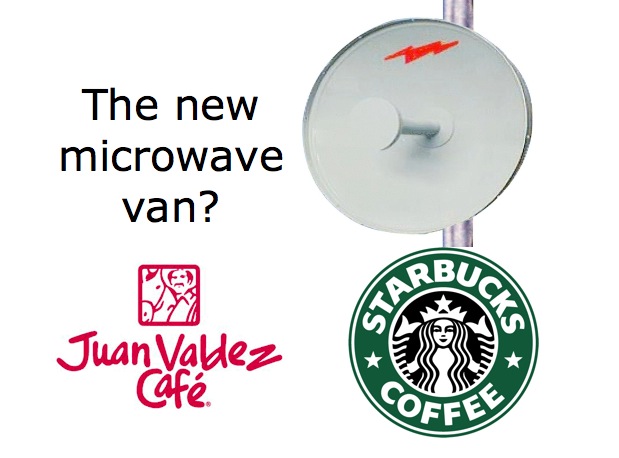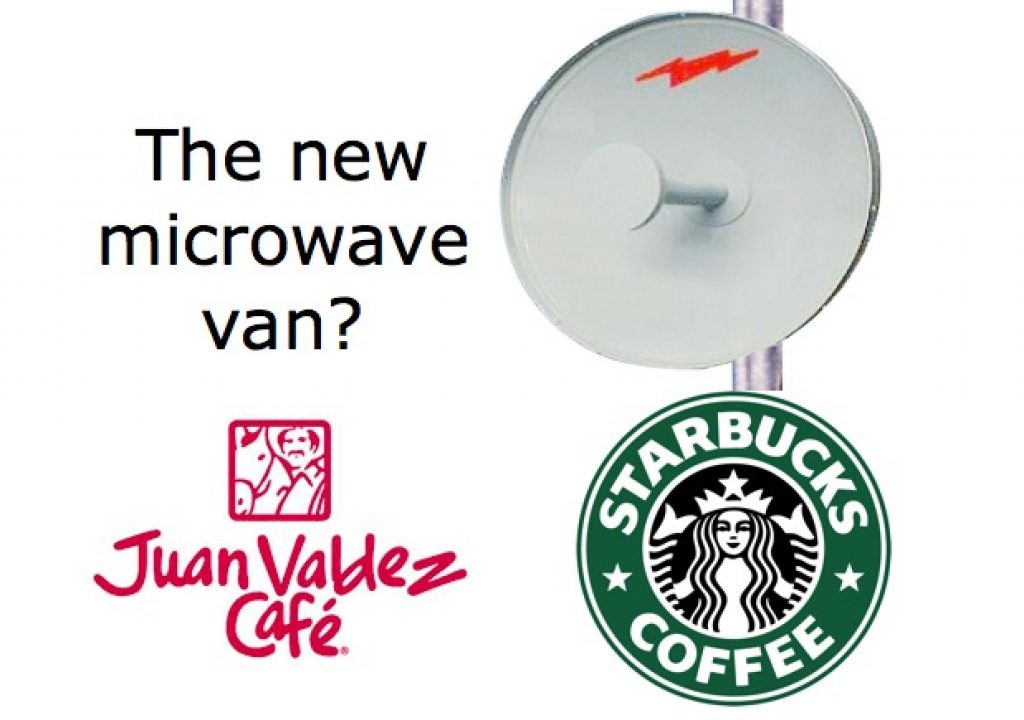
If you’re involved in traditional broadcast news, you know that the most popular established way to send your urgent remote stories back to the TV station is via microwave. For those unfamiliar, I’m not talking about a microwave oven, but a microwave transmitter often installed inside of a news van (OB truck), and often with a parabolic antenna on top. At NAB 2012, a recurring theme was: “Starbucks is the new microwave!” or some variation thereof, for urgent (but not live) news packages. Of course, if you’re in broadcast news in Colombia, South America, then the phrase might be: “¡Juan Valdez es mi nuevo transmisor microonda!”. Obviously, this refers to the free WiFi service available at Starbucks (at least in their USA locations) and at Juan Valdez in Colombia, together with the comfort of editing (optionally) and uploading raw news footage or edited packages from a very cozy environment. Let’s review a couple of such examples from NAB, and compare Internet caf© WiFi upload speeds to that of “4G” LTE in the USA.
Avid’s Interplay Sphere
During its NAB 2012 press conference, Avid announced Interplay Sphere, a real-time access solution enabling broadcast news professionals to acquire, access, edit, and finish stories anytime, from anywhere. At the press conference, Avid commented: “With the ability of Sphere to get access to all of your content, whether you are in an OB truck or a Starbucks, anything is possible.”
JVC announced its new GY-HM650 news camera with WiFi + FTP
At NAB 2012, JVC announced its new GY-HM650 news camera with WiFi + FTP. The premise is that you upload unedited footage (files) directly from the camera to the FTP server, and then they either edit it at the station or you access the uploaded raw footage and use any cloud-based editing solution to edit. The GY-HM650 is a “WorldCam” model, offering 50Hz/59.94Hz framerate coverage in 1080p, 1080i, and 720p in multiple códecs: MPEG2 long GOP (XDCAM EX compliant) and H.264 long GOP (AVCHD). I hope they eventually offer the option of UDF-formatting and single simple files even for long clips, as I covered in detail in this recent Open Letter to professional AVCHD camera manufacturers. In addition to the HD modes stated, the GY-HM650 can also record standard definition (PAL/NTSC derived digital files).
Any ProVideo Coalition magazine reader who remembers my 2009 article called SFTP: An open letter to all software developers with FTP-only support knows that I only recommend SFTP (Secure FTP), since with standard FTP, the password travels through the Internet without encryption, so a hacker can easily “sniff” it. So I contacted David Walton, assistant vice president of marketing communications at JVC Professional Products Company to ask whether the GY-HM650 would support SFTP too (in addition to standard FTP). I also asked him what 802.11 versions the GY-HM650 supported (i.e 802.11a, 802.11b, 802.11g, 802.11n, etc) and what frequency bands (i.e. 2.4 GHz, 5 GHz, or both). Within less than 24 hours, Walton replied:
The GY-HM650 is still in development and won’t be available until the end of this year. Not all of the software issues are decided. I don’t believe that the final FTP protocol has been finalized, so it’s too early to address the secure FTP question.
We are still testing WiFi modules and therefore cannot answer your 802.11x questions either.
I’ll pass your inquiry along to our engineering team who will keep you updated when there’s further information.
Thanks for inquiring.
This isn’t the first time JVC has offered an Internet approach to newsgathering, although the last time it was more of a “live” approach rather than a file-based one with the GY-HM650.
GY-DV300 from 2002, with docked KA-DV300 module
Back in 2002, JVC launched the GY-DV300 “StreamCorder” which could stream MPEG4 (ISMA) using the optional KA-DV300 streaming module which would dock below the camera and had a slot for a wired or wireless LAN or WLAN card. That was in the SD (Standard Definition) days. At that time, JVC contracted me to demonstrate the live streaming features of the GY-DV300 at NAB 2002. It is amazing that that happened ten years ago!
Starbucks upload speeds versus “4G” LTE upload speeds in the USA
Upload speeds with Verizon’s LTE in the USA are reported between 10–19 Mb/s, so you could use an iPad (2012) with “4G” LTE with its hot spot function. Be sure to negotiate an appropriate plan for your monthly bandwidth requirements. On the other hand, Starbucks upload speed is usually less than 1 Mb/s.
If you’re not in a Verizon LTE area: another wireless provider of “4G” mobile service which even offers unlimited data for US$50/month (including all taxes) is H2O, which uses the AT&T network as an MVNO (mobile virtual network operator), and promises upload speeds up to 5.76 Mb/s. That’s not as fast as typical Verizon LTE upload speeds (where available), but it’s much better than the typical Starbucks upload speed.
Their H2O Bolt Spider Hotspot device costs US$139.99 at publication time, allows up to eight connected devices, and requires no long term contract. I have not tried this myself yet.
Moral of the story
Bring your iPad 2012 with “4G” LTE or your H2O Bolt Spider Hotspot device to Starbucks, and use it as your primary connection to connect to your laptop or WiFi-powered camera to connect and upload, preferably using SFTP. If possible, bring one of each as a backup. Use the Starbucks WiFi connection as a third-level backup, and enjoy the environment and the refreshments, even if you aren’t using their WiFi. Oh, and be sure to use password protection on your mobile hotspot on either device: You won’t want to share your bandwidth with everyone present.
Some upcoming articles
Some of my upcoming articles articles will include :
- part 2 of my review called 1st handheld dynamic microphones with hybrid XLR/USB/iPad connectivity from Audio Technica (part 1 is available here)
- Why iPad video editing apps like iMovie for iPad and Avid Studio for iPad currently work better for traditional broadcast news than for new age Internet news
- More microphones and preamplifiers for iPad
To make sure you continue to see my upcoming articles, sign up to my mailing list here.
Allan T©pper’s books, consulting, articles, seminars & audio programs
Contact Allan T©pper for consulting, or find a full listing of his books, articles and upcoming seminars and webinars at AllanTepper.com. Listen to his TecnoTur program, which is now available both in Castilian (aka “Spanish”) and in English, free of charge. Search for TecnoTur in iTunes or visit TecnoTur.us for more information.Disclosure, to comply with the FTC’s rules
No manufacturer is specifically paying Allan T©pper or TecnoTur LLC to write this article. Some of the other manufacturers listed above have contracted T©pper and/or TecnoTur LLC to carry out consulting and/or translations/localizations/transceations. Many of the manufacturers listed above have sent Allan T©pper review units. So far, none of the manufacturers listed above is/are sponsors of the TecnoTur programs, although they are welcome to do so, and some are, may be (or may have been) sponsors of ProVideo Coalition magazine. Some links to third parties listed in this article and/or on this web page may indirectly benefit TecnoTur LLC via affiliate programs.
Copyright and use of this article
The articles contained in the TecnoTur channel in ProVideo Coalition magazine are copyright Allan T©pper/TecnoTur LLC, except where otherwise attributed. Unauthorized use is prohibited without prior approval, except for short quotes which link back to this page, which are encouraged!

